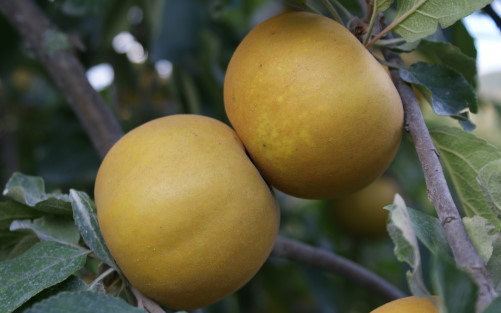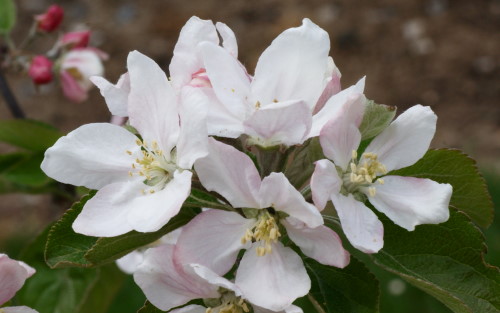
Saint Edmund's Pippin is a typical English russet apple - sometimes known as Saint Edmund's Russet. It is very similar to the more widely-known Egremont Russet. Its season is slightly earlier and it does not keep particularly well. The flavour however is arguably richer than Egremont Russet, and the flesh seems juicier - it is not necessarily a better apple, but fans of russet apples tend to think the flavour is superior.
Although a tendency to russeting is a feature of many apple families and varieties (including Golden Delicious and Cox's Orange Pippin), those varieties which exhibit heavy or complete russeting such as Saint Edmund's Pippin are clearly closely related to each other in some way - although interestingly very little is known about the parentage of any of the classic russet varieties. However these russet varieties are often very good varieties for the garden - the trees generally grow in a neat fashion and have very good disease resistance, and tolerate a wide range of growing situations.
Again like several other russet varieties, Saint Edmund's Pippin produces a good juice and can be used for cider production.
Saint Edmund's Pippin apple identification images
All images copyright Orange Pippin unless otherwise stated.
USDA identification images for Saint Edmund's Pippin
The identification paintings in the USDA Pomological Watercolor Collection span the years 1886 to 1942.
Citation: U.S. Department of Agriculture Pomological Watercolor Collection. Rare and Special Collections, National Agricultural Library, Beltsville, MD 20705.
Visitor reviews
- 26 Sep 2024On M26 rootstock, had this since 2017. Sheffield UK at 220m elevation. One tree, not in best spot, This year 26 Sept, fruit has an incredible depth of flavour. Thin skin, sweet and acidic, somewhere between honey and pear with a floral/russet finish. Can't stress enough that it's only fully ripe if there's at least some rosy blush on the fruit.
- 24 Aug 2024 OHIO (OH), United StatesProbably one of the top five best flavored apples I've ever tasted. Nice and sweet with a perfect balance of acidity. Complex, rich flavor with wonderful, distinctive pear notes.
- 15 Oct 2019 ANGUS, United KingdomThe best apple known to mankind. Not only is it the best russet it is even tastier than other megahits like Ashmeads, Kidds and maybe even Cox. It is also a very healthy tree and clean fruit
- 09 Oct 2018 CORNWALL, United KingdomLove this variety. It is sweet but tangy, richly flavoured, easy to grow. Juicier than Egremont, superior to Egremont in my opinion. Damp climate proof, no disease at all over the last 5 years. Downsides: it does not keep at all, max 2 weeks and turns brown very quickly and leans to tip bearing. But if you are looking for a russet apple with great flavour that is diseases resistant, this is definately worth considering.
- 16 Sep 2016 MASSACHUSETTS, United StatesHints of lime citrus in crisp white flesh. Not particularly juicy but not dry either. Dull yellow skin with marks of russetting here in New England.
- 30 Apr 2016 DOWNTON WILTSHIRE, United KingdomI've always loved Egremonts but this is an even nicer russet. Do be careful to let it ripen on the tree otherwise it can be disappointing.
- 06 Oct 2013 NORTH YORKSHIRE, United KingdomMy favourite russett apple. Sweet and juicy with a touch of pear flavour. Crops reasonably well in most years in North England.
- 07 Jan 2012 United KingdomMy favorite apple - I liked it so much I bought the tree. Crops well for an early.
Tree register
United States
- Aaron in Jenks, OK/TULSA
- Axel Kratel in Santa Cruz, CALIFORNIA
- Dan Spratlen in Camano Island, WASHINGTON
- David Horn in Purcellville, VIRGINIA/LOUDOUN
- David Horn in Purcellville, VIRGINIA/LOUDOUN
- fendwick in Bemidji, MN
- g Joseph Jordan in WEST CHESTER, PA
- Herdie Baisden in STOCKHOLM, WI
- Jerry Hudgins in Point Reyes Station, CALIFORNIA
- Joel Howie in Canton, NEW YORK
- Michael Freeman in Ben Lomond, CA
- Michelle Smith in Skye Glen, NOVA SCOTIA
- Mike Coogan in Tenino, WA.
- Mike Haller in SIOUX CITY, IOWA
- Rebecca Schwendler in Lafayette, CO
- Ricky Bruckner in Ravenna, OHIO (OH)
- Scott Atkins in PORTLAND, OR
- Steven Stanley in Johnson City, TENNESSEE
- Terry Graham in Tumwater, WA
- Trevor Roth in Erhard, MINNESOTA
United Kingdom
- Reach Community Orchard in Cambridge,
- Reach Community Orchard in Cambridge,
- Reach Community Orchard in Cambridge,
- Bill Barker And Sharon Cherry in LEICESTERSHIRE
- Colin Bowen in
- David in Hereford,
- David Neilson in ELY, CAMBS
- Edward Evans in MANNINGTREE, SUFFOLK
- Graham Charles Schofield in Newmarket, SUFFOLK
- Graham Hinchliffe in Eastbourne, EAST SUSSEX
- Jean Lippett in Martock, SOMERSET
- Jon Gregory in LEWES, EAST SUSSEX
- Jude Ilett in Peasenhall, SUFFOLK
- Kevinincornwall in Liskeard, UNITED KINGDOM
- Phil in Stoke-On-Trent, STAFFS
- Steve Sim in Grange Over Sands, CUMBRIA
- Thomas Bennell in BRISTOL,
- Zoe Mitchell in Milton Keynes, UNITED KINGDOM
Ireland
- Dan Kissane in Killarney, CO KERRY.
Netherlands
- Cheuk A Lam in Amsterdam, NOORD-HOLLAND
Canada
- Erik Nordenson in Cobourg, ONTARIO
Australia
- Stephen Boardman in Acton Park, TAS
- Stephen Boardman in Acton Park, TAS
- Stephen Boardman in ACTON PARK, Tasmania
Spring blossom records for this variety
2020 season
- 22nd April 2020 - tree owned by Jerry in Point Reyes Station, United States
- April 2020 - tree owned by Rebecca in Lafayette, United States
2019 season
- 22nd April 2019 - tree owned by Jerry in Point Reyes Station, United States
2017 season
- 22nd April 2017 - tree owned by Bill in , United Kingdom
2016 season
- 9th May 2016 - tree owned by Bill in , United Kingdom
2015 season
- 27th April 2015 - tree owned by Bill in , United Kingdom
2014 season
- 21st April 2014 - tree owned by Zoe in Milton Keynes, United Kingdom
- 19th April 2014 - tree owned by Bill in , United Kingdom
2013 season
- 15th May 2013 - tree owned by Jean in Martock, United Kingdom
- 13th May 2013 - tree owned by Bill in , United Kingdom
Record your blossom dates in our Fruit Tree Register - more >>.
Harvest records for this variety
2017 season
- 2nd week September 2017 - tree owned by Bill in , United Kingdom
2016 season
- 3rd week September 2016 - tree owned by Bill in , United Kingdom
2015 season
- 3rd week September 2015 - tree owned by Bill in , United Kingdom
2013 season
- 4th week September 2013 - tree owned by Zoe in Milton Keynes, United Kingdom
- 3rd week September 2013 - tree owned by Bill in , United Kingdom
2011 season
- 2nd week September 2011 - tree owned by Jude in Peasenhall, United Kingdom
Origins
- Species: Malus domestica - Apple
- Parentage: Unknown
- Originates from: Bury St. Edmunds, Suffolk, England, United Kingdom
- Introduced: 1875
- Developed by: Mr R. Harvey
- UK National Fruit Collection accession: 1977-161
Identification
- Awards: RHS AGM (current)
- Country of origin: United Kingdom
- Period of origin: 1850 - 1899
- Fruit colour: Russet
- Flower colour: White
- Leaf colour: Green
- Popularity: Rarely grown
- Annual cycle: Deciduous
Using
- Picking season: Mid
- Keeping (of fruit): 2-3 weeks
- Flavour quality: Very good
- Flavour style (apples): Sweeter
- Discoloration of fruit: Oxidising
- Cropping: Good
- Fruit persistence: Normal ripening
- Food uses: Eating fresh
- Food uses: Juice
- Food uses: Hard cider
- Picking period: mid-September
- Wildlife: RHS Plants for Pollinators
Growing
- Gardening skill: Beginner
- Flowering group: 3
- Pollinating others: Average
- Ploidy: Diploid
- Vigour: Slightly small
- Bearing regularity: Regular
- Fruit bearing: Partial tip-bearer
- Attractive features: Attractive fruit
- Self-fertility: Partially self-fertile
- Feathers on maiden: Rarely has feathers (whip)
Climate
- Cold hardiness (USDA): Zone 5 (-29C)
- Climate suitability: Temperate climates
- Climate suitability: Mild damp climates
- Summer average maximum temperatures: Cool ( 20-24C / 68-75F)
- Summer average maximum temperatures: Warm (25-30C / 76-85F)
- Cold hardiness (RHS): H6 (to -20C)
Other qualities
- Disease resistance: Good
- Scab (Apple and Pear): Very resistant
- Canker: Some resistance
- Powdery mildew: Some resistance
- Cedar apple rust: Some resistance
Where to buy trees
The following tree nurseries offer Saint Edmund's Pippin apple trees for sale:
- Orange Pippin Fruit Trees (USA) United States
Saint Edmund's Russet apple trees - Orange Pippin Fruit Trees (UK) United Kingdom
Saint Edmund's Russet apple trees - Thomas Fruit Trees (EU) France
Saint Edmund's Russet apple trees
Where to buy fresh fruit
The following orchards grow Saint Edmund's Pippin:
United States
Indiana
- Doud's Countyline Orchard, Wabash
Iowa
- Wilson's Orchard, Iowa City
Maine
- Hooper's Orchard, Monroe
- Tiny Orchards, Saco
Michigan
United Kingdom
England - midlands
- Walsgrove Farm, Worcester
Canada
British Columbia
- Salt Spring Apple Company, Salt Spring Island
References
- Apples of England (1948)
Author: Taylor - Fruit Expert
Author: Hessayon - Some Antique Apples for Modern Orchards, (2008)
Author: Merwin I.A.


